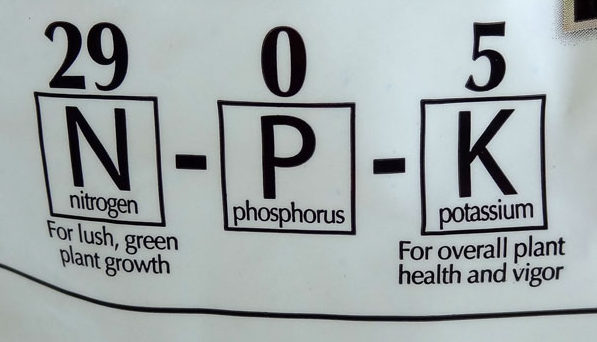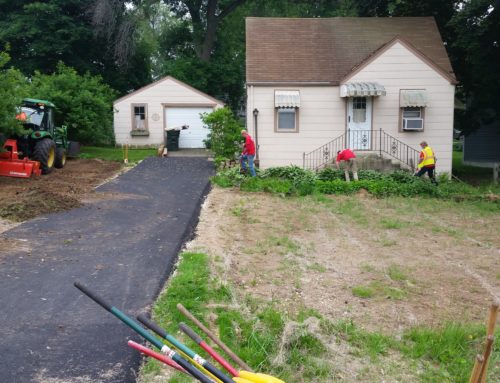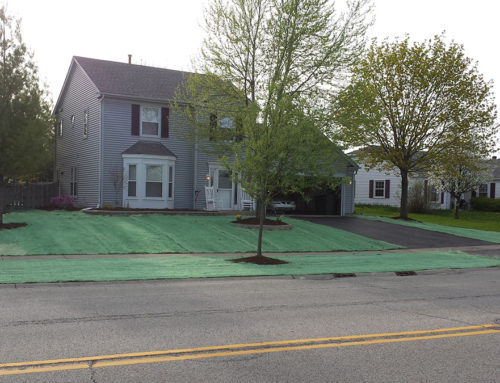What Are N-P-K & Their Role In Fertilizer?
All fertilizers use a three number rating system, like 15-15-15, or 21-7-14
The first number represents Nitrogen, the second is Phosphorous, the third is Potassium (or Potash). These numbers are percentages of the total ingredients in the bag.
This is how fertilizer ratios work. For an example, let’s use fertilizer numbers with an NPK rating of 21-7-14. Nitrogen has the highest concentration at 21%. It is 3 times the amount of phosphorous at 7%. Phosphorous is only half of the Potassium amount of 14%. Technically, this would be called a 3-1-2 ratio.
Look at any set of fertilizer ratios on a label. Notice how the numbers relate to each other by size:
• 21-7-14 is Big – Small – Medium
• 21-3-3 is Big – Small – Small
• 6-20-20 is Small – Big – Big
• 21-0-0 is Big – Zero – Zero
The N-P-K rating you want for grass typically is Big – Small – Small. If you follow this, you see that grass needs a lot of Nitrogen and a little bit of the other stuff. That’s the essential part.
Why Do The Fertilizer Numbers Matter?
A brief description of each major nutrient will show why grass has its own preference for fertilizer.
Nitrogen:
• essential for growth of foliage;
• produces lush, tender, green leaves (or grass blades);
• deficiency results in a yellow-green color (chlorosis) and little or no growth;
• is easily flushed through the soil.
Phosphorous:
• stimulates root growth;
• hastens the maturity of plants;
• promotes the development of flowers, fruits, seeds;
• deficiency can result in slow or stunted growth and purplish discoloration on leaves;
• remains in the soil quite well.
Potassium:
• gives the vigor to tolerate changing weather conditions;
• helps resist disease;
• assists in the food manufacturing process;
• strengthens cell wall structure for strong stems;
• deficiency can cause weak stems and slow growth;
• leaches from the soil, not so fast as nitrogen.
How Can This Save You Money?
Look at the current status of your lawn.
An Established Lawn:
needs primarily nitrogen, since it is not producing any fruit or flowers, or Big – Small – Small. Nitrogen is the least expensive of the nutrients. Don’t buy a formula that has high phosphorous or potassium when you don’t need them.
A New Lawn:
is special and needs more phosphorous to produce roots. Don’t use high-nitrogen because the roots are not ready to handle top growth. Go with Small – Big – Big. Phosphorous and potassium are more costly, so you would not use this all the time. Yet, investing in the more expensive list of ingredients for a new or damaged lawn is wise.
New Sod:
Be safe when you fertilize new sod! It looks like a mature lawn, but the roots have been shaved off and it needs to recover. Save the expense of redoing this huge project. You can kill the young lawn with the wrong blend. Avoid stress and later expensive problems by helping the grass get established properly. Use Small – Big – Big or Zero – Big – Big.
A Stressed Lawn:
(e.g. – preparing for winter or extreme heat) needs more potassium. Try Big – Small – Medium or Big – Small – Big
When the grass has stressful conditions to deal with, applying the more expensive potassium can prevent problems from developing or continuing. Pay now and don’t pay later.
Thus, if the fertilizer with higher numbers in the ratio is on sale, and your lawn would benefit from those nutrients, then you can apply it with confidence, knowing you got a good deal.
Be cautious though, about applying high phosphorous continually to a lawn area. Mature grass doesn’t need it, and the environment doesn’t either.
To print this guide click here.




